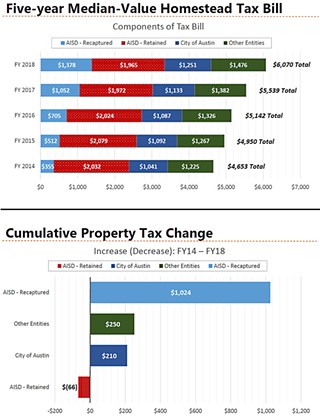Public Notice: Other People’s Money?
Actually, it’s yours. Do you know where it’s going?
By Nick Barbaro, Fri., Aug. 4, 2017
Last week I wrote about The Austin Environmental Directory 2017-18, a ninth-edition resource recently released by utility and consumer watchdog Paul Robbins. This week Robbins is at it again, releasing another long-awaited follow-up report, titled Misguided Charity, charging that money from Austin Energy's Customer Assistance Program (CAP) – those voluntary contributions that utility customers can make to defray costs for the needy, (*but also a percentage of every utility bill you pay) – is in some cases going instead to wealthy property owners, and to subsidize wasteful consumption.
In a nutshell, Robbins had notified AE and City Council almost three years ago that "I had found its automatic enrollment strategy was giving discounts to customers that had high-valued real estate assets. … I had discovered over 1,100 CAP participants that had high real property assets; 66 of them owned or co-owned over $1 million in real estate." There was some attention and policy direction from Council, but as of yet, there's been no change in the actual electric and water utility tariffs that would change the participation guidelines.
In this new report, Robbins makes two major policy recommendations: First, that the program should "verify that customers who live in properties with high improvement values really do have low incomes. Council unanimously budgeted money for this in August of 2016 … This could be enacted in a matter of weeks." Second, and perhaps even easier, would be for AE to eliminate the CAP discount for high-volume electricity users – specifically the fourth and fifth tiers of consumption. "This is just wrong!" Robbins said in a separate email. "The practice encourages waste, while at the same time depriving the average CAP participant of additional discount money." He estimates this move alone could save the utility some $2 million a year, enough to "increase the average electric discount of $250 a year by about $60."
He also asks for an audit of the CAP program, and a customer survey, and for a move toward phasing out the automatic enrollment policy, and income qualifying all CAP recipients.
Appendices include a "Parade of Homes" – photos and stats on luxury homes that were receiving the CAP discounts as of this January – plus a list of some 56 "CAP Customers With More Than $1 Million in Real Estate Assets." The report is being distributed to Council and others today, Aug. 3, and will soon be available for download at www.environmentaldirectory.info.
Mayor Steve Adler was sufficiently fired up by this week's budget session highlighting the tax bite the state of Texas is taking out of Austin property taxpayers to fund the state's public school system ("Point Austin," Aug. 4), that he fired off a quick press release with the subject line, "Statement by Mayor on Texas Taking More Taxes Than Austin Is Getting." In the spare 129-word release (the Gettysburg Address was 272), Adler "explains why property taxes are so high for Austin taxpayers. … Only four years ago, the state [of Texas] got a third of what Austin got. … Next year, for the first time, the state will be taking more than Austin gets. Our property taxes are no longer a local property tax. From this day forward, let's call it what it is, a state property tax." Accompanying charts illustrate the $1,024 increase in state taxes on the median Austin homestead in the last four years, while AISD's take-home has actually declined.
The Austin Animal Center is asking for folks to participate in their Summer Camp 2017 foster program. With a lot of lost pets this time of year, the center is at capacity, and looking for folks to take an adult dog or cat for a two-week sleepover camp. See full info at www.austinanimalcenter.org.
This year's sales tax holiday is next weekend, Fri.- Sun., Aug. 11-13, exempting most clothing, footwear, school supplies, and backpacks priced under $100 from sales tax. See the full list at www.texastaxholiday.org.
Favorite press release of the week: "Media Alert. 'Kentuckians for Coal' to Protest the Solar Eclipse August 21!" This is a real event, in Hopkinsville, Ky. I may have more on this story next week.
* Note: This item has been changed from the original, adding the parenthetical in the first paragraph to clarify that the CAP funding comes not only from voluntary contributions, but primarily through utility rates – in fact, Robbins says, "less than 1% of its budget comes from voluntary contributions." Meanwhile, "for Residential customers in the Austin City Limits, CAP represents roughly 1.5 to 2% of the total electric bill."
Got something to say on the subject? Send a letter to the editor.











